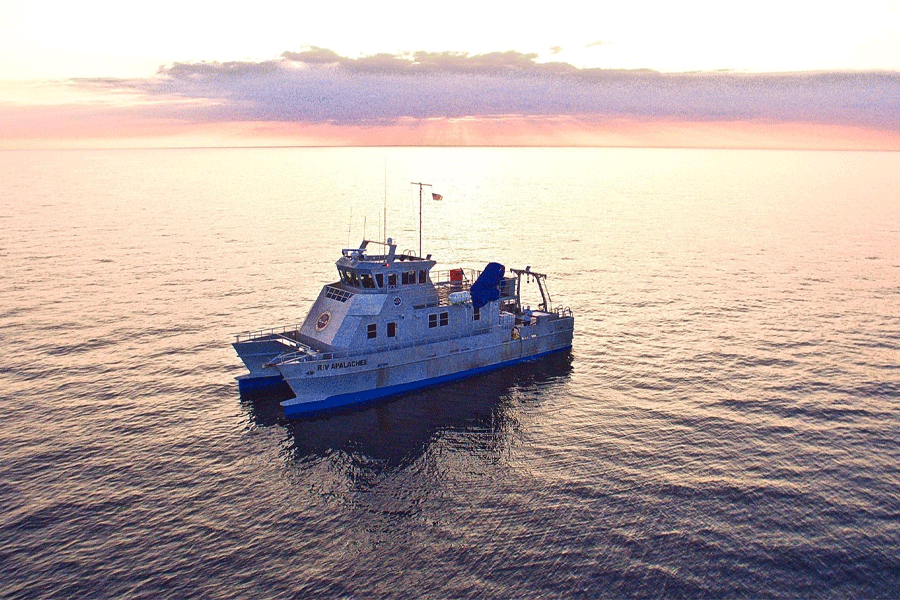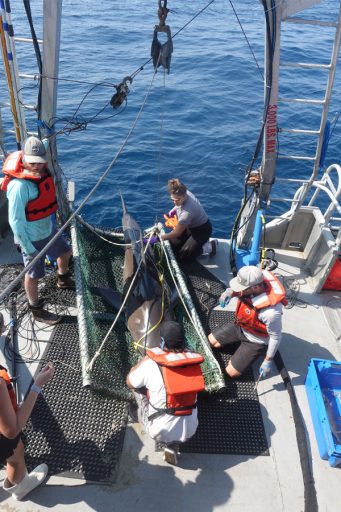
When Florida State University researcher Dean Grubbs wants to gather data, he heads to sea. It’s there, in the Gulf of Mexico, and sometimes at depths of more than a mile underwater, where he’s able to find the information he needs for his research into sharks, rays and other marine wildlife.
The work wouldn’t be possible without the R/V Apalachee, a 63-foot research vessel docked at the FSU Coastal and Marine Laboratory in St. Teresa, Florida, and the largest ship in the lab’s fleet. The ship is the largest research vessel between the Tampa Bay area and Mobile, Alabama, making it an important tool for anyone who wants to do research on the northern Gulf.

“The Apalachee has proven indispensable in our research, particularly in our efforts to study the effects of the Deepwater Horizon oil spill on deep sea ecosystems,” Grubbs said. “These cruises have led to 10 peer-reviewed papers so far, and we’ve been able to document more than 100 species of large deep-sea sharks and bony fishes, including species that had never been seen in the Gulf of Mexico and even some that were new to science.”
On board the ship, scientists like Grubbs can undertake weeks-long research cruises to collect information that’s crucial to understanding the Gulf ecosystem. The research the ship makes possible informs policies that help keep the Gulf healthy. Surveys of grouper, sharks and other marine wildlife are used by state and federal fisheries managers to help set catch allotments and to provide other important management information.
“The R/V Apalachee is a tremendous resource for the FSU Coastal and Marine Laboratory,” said Joel Trexler, director of the marine lab. “It gives us an opportunity to extend the reach of our scientific work beyond the immediate coastal waters that are accessible by smaller boats. It also allows us to do types of work that just can’t be done on a smaller platform.”
The environment for that work ranges from underwater canyons to shallow coastal waters. The vessel’s shallow draft allows Captain Matt Edwards to navigate it into a wide range of environments where scientists might want to work. The ship is a versatile workhorse.
For example, several recent research cruises took scientists to gather data on the flat, burrowing sea urchins commonly called sand dollars. It would have been possible to reach the field sites on a smaller vessel, but the Apalachee offers a better resource for the work. The ship’s dive platform makes it easy for researchers to access the water and collect the information they need.
The ship also hosts students completing academic diving training. It can accommodate a class of two dozen students and instructors, along with their gear. Students typically visit old military towers to practice the skills they need to complete underwater academic work.
“They dive on it and take measurements, and it’s a very cool thing because those towers are full of fish throughout the year,” Edwards said. “There’s barracuda, amberjack, snapper, grouper — all kinds of stuff. Those students are fortunate enough to be able to hop in the water and see great things like that. They can safely accomplish that goal on the Apalachee.”
In addition to FSU researchers and students, the vessel is also a resource for outside research groups that want to investigate the Gulf. The National Oceanic and Atmospheric Administration, the United States Geological Survey, the Florida Fish and Wildlife Conservation Commission, Mote Marine Laboratory and Aquarium and others have chartered the ship for research projects. Businesses also charter the vessel for research.
“The Apalachee really helps fill a gap here to provide information for management of our natural resources in this region of Florida,” Trexler said. “If it weren’t available, it would be a real disadvantage for resource managers.”




